| Article ID | Journal | Published Year | Pages | File Type |
|---|---|---|---|---|
| 2449542 | Meat Science | 2016 | 6 Pages |
•Higher Pseudomonas and TTC counts in cuts than hindquarters and deboning surfaces•High and constant counts of Pseudomonas and LAB in meat cuts over the shelf-life•Vacuum loss and sensory changes during meat cuts shelf-life•Presence of Listeria spp. in hindquarter and meat cuts during cold storage•Similar microbiological characteristics between buffalo meat and meat from other species
Considering the specific biochemical composition of buffalo (Bubalus bubalis) meat (high iron content, high biological value proteins and essential fatty acids, low amounts of fat and cholesterol), we evaluated the influence of cutting and deboning operations on the microbiological quality and shelf-life of vacuum-packed buffalo meat stored under refrigeration. On the processing day, samples were collected from carcass, deboning room surfaces and meat cuts. Samples from meat cuts were evaluated weekly for two months. On the processing day, higher counts of Pseudomonas spp. were observed in samples from meat cuts compared with the hindquarters and the processing surfaces. For thermotolerant coliform scores, the averages were − 0.5 log MPN·cm− 2, − 0.4 log MPN·cm− 2 and 0.9 log MPN·g− 1, respectively. Higher counts of Pseudomonas spp. and LAB in meat cuts were observed on the processing day and after the first week of storage, respectively, remaining constant during shelf life. Listeria grayi was identified in two samples of hindquarters and meat cuts during storage. Listeria innocua was identified in one meat cut. In conclusion, cutting and deboning operations influence the microbiological quality and shelf life of vacuum-packed buffalo meat stored under refrigeration.
